Navigating the world of sim racing hardware can be complex, with various brands and technologies each offering a different experience. For enthusiasts looking to move beyond a standard gamepad, a racing wheel and pedal set is the most significant upgrade to enhance immersion and control in titles like Gran Turismo 7, Assetto Corsa Competizione, or iRacing. The market is dominated by a few key players—Logitech, Thrustmaster, and Fanatec—each occupying a distinct tier, while brands like Hori and PXN provide accessible entry points.
This purely informational guide offers an objective breakdown of the core technologies, specific product models, and brand philosophies to help you understand the landscape. We will analyze the key differences in force feedback, build quality, and ecosystem to provide a clear picture of what each brand offers.
Racing Wheel Specifications: A Head-to-Head Comparison
This table provides a direct, at-a-glance comparison of the key technical specifications for the models analyzed in this guide.
| Feature | Logitech G29 | Logitech G923 | HORI Racing Wheel Apex | Thrustmaster T248 | PXN V9 |
| Force Feedback Type | Dual-Motor (Gear-Driven) | Dual-Motor (Gear) with TRUEFORCE | Vibration (Rumble) | Hybrid (Belt + Gear) | Dual-Motor Vibration |
| Max. Rotation Angle | 900° | 900° | 270° | 900° | 270° / 900° (Switchable) |
| Platform Compatibility | PS5, PS4, PS3, PC | PS5, PS4, PC (Also Xbox version) | PS5, PS4, PC | PS5, PS4, PC (Also Xbox version) | PC, PS4, Xbox One, Xbox Series X/S |
| Pedal Set Included | 3-Pedal (Throttle, Brake, Clutch) | 3-Pedal (Progressive Brake) | 2-Pedal (Throttle, Brake) | 3-Pedal (Magnetic, Adj. Brake) | 3-Pedal (Throttle, Brake, Clutch) |
| External Shifter | Sold Separately | Sold Separately | Not Available | Sold Separately | Included (6-Speed H-Pattern) |
| Wheel Rim Materials | Hand-Stitched Leather, Aluminum | Hand-Stitched Leather, Aluminum | Molded Plastic, Rubber Grips | Leather-Wrapped Foam, Plastic | Imitation Leather, Plastic |
| Brake Technology | Potentiometer w/ Rubber Stop | Progressive Spring | Potentiometer | Magnetic (H.E.A.R.T) | Potentiometer |
| RPM Indicator LED | Yes | Yes | No | No (On-Screen Display) | No |
| Primary Price Tier | Entry-Level | Lower Mid-Range | Budget / Entry-Level | Mid-Range | Budget / Entry-Level |
| Key Differentiator | Proven, reliable entry FFB wheel | TRUEFORCE Audio-Based Feedback | Low cost, no true Force Feedback | Hybrid Drive & LCD Screen | Included Shifter |
Understanding Core Technology: What is Force Feedback?
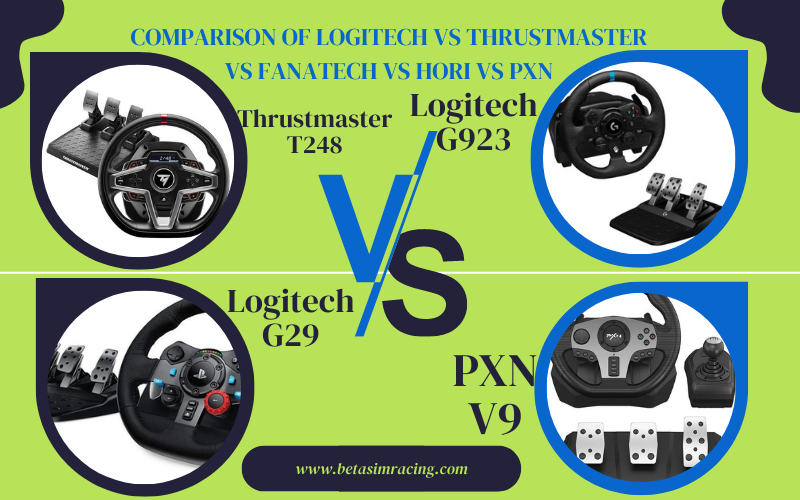
Force feedback (FFB) is the single most important feature of a sim racing wheel. It’s a system that uses motors to resist your steering inputs and simulate what a driver would feel through the wheel of a real car. This includes the pull of g-forces in a corner, the loss of traction, bumps in the road, and the texture of the track surface. The type of FFB system used is the primary differentiator between budget, mid-range, and high-end wheels. For those interested in the pinnacle of this technology, exploring a full range of direct drive wheels is a logical next step.
Gear-Driven Systems (Logitech)
Gear-driven systems, like those in the Logitech G29 and G923, are the most established form of force feedback. They use a set of helical gears to transfer and amplify the forces from a small motor to the steering shaft.
- Characteristics: This system is known for being reliable and delivering strong, punchy feedback. However, the nature of metal gears meshing can sometimes result in a slightly “notchy” or grainy feeling during rotation and can be louder than other systems.
- Ideal For: Beginners and enthusiasts looking for a proven, cost-effective entry into true force feedback.
Hybrid Belt/Gear Systems (Thrustmaster)
Hybrid systems, found in the Thrustmaster T248, combine the elements of both belt and gear-driven mechanisms. This approach aims to deliver the best of both worlds.
- Characteristics: A belt runs from the motor to a gear, which then turns the wheel. The belt helps to smooth out the “notchy” feeling often associated with pure gear systems, resulting in a more fluid and often quieter experience. This can transmit more nuanced details from the road surface.
- Ideal For: Sim racers who want a smoother, more detailed experience than entry-level gear-driven wheels without moving to the higher cost of direct drive.
Direct Drive Systems (Fanatec)
Considered the gold standard in sim racing, direct drive (DD) systems mount the steering wheel directly onto the shaft of a large, high-torque industrial motor.
- Characteristics: By eliminating gears and belts, there is no loss or dampening of force. The result is the most precise, detailed, and powerful force feedback possible, capable of relaying everything from the subtlest tire slip to the most violent curb strikes with unparalleled realism. The Fanatec CSL DD is a popular entry point into this category.
- Ideal For: Serious sim racers and professionals who demand the highest level of fidelity and immersion.
Vibration & Rumble Feedback (Hori, PXN)
Budget-tier wheels often use vibration or rumble feedback instead of a true force feedback system.
- Characteristics: This technology does not use motors to actively resist your inputs. Instead, it uses vibration motors, similar to those in a standard gamepad, to shake the wheel during events like collisions or driving over rough surfaces. It provides a tactile sensation but does not simulate the physics of steering.
- Ideal For: Casual gamers, younger players, or those on a strict budget who want a more engaging experience than a controller but are not yet ready to invest in a full FFB system.
In-Depth Product Analysis
Here is an objective, fact-based breakdown of the five racing wheels featured in this guide. All subjective sales language has been removed in favor of informational analysis.
Logitech G29 Driving Force
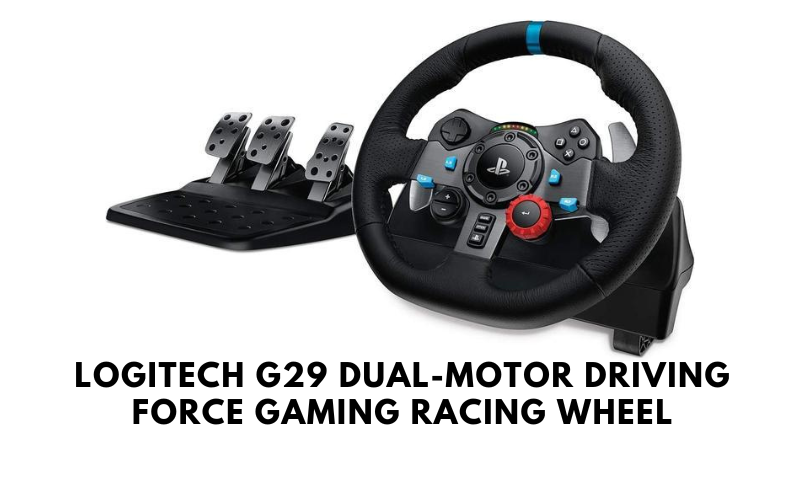
The Logitech G29 (and its Xbox-compatible counterpart, the Logitech G920) has been a benchmark for entry-level sim racing for years. Though succeeded by the G923, it remains in production and offers a complete, reliable package. For a detailed look at this specific model, a full Logitech G29 review is available.
Key Specifications
- Force Feedback: Gear-Driven Dual-Motor
- Rotation: 900° Lock-to-Lock
- Compatibility: PlayStation 5, PS4, PS3, PC
- Pedals: 3-pedal set (Throttle, Brake, Clutch)
Objective Analysis
The G29’s longevity is a testament to its solid construction, featuring a hand-stitched leather wheel and stainless steel paddle shifters. Its gear-driven force feedback is strong and provides all the essential cues needed for car control. The included three-pedal set with a clutch is a significant feature at its price point, allowing for the use of a separate H-pattern shifter for a more authentic manual driving experience. While its underlying technology has been surpassed by newer systems, its proven reliability and complete ecosystem make it a consistent choice for new sim racers.
Logitech G923 TRUEFORCE
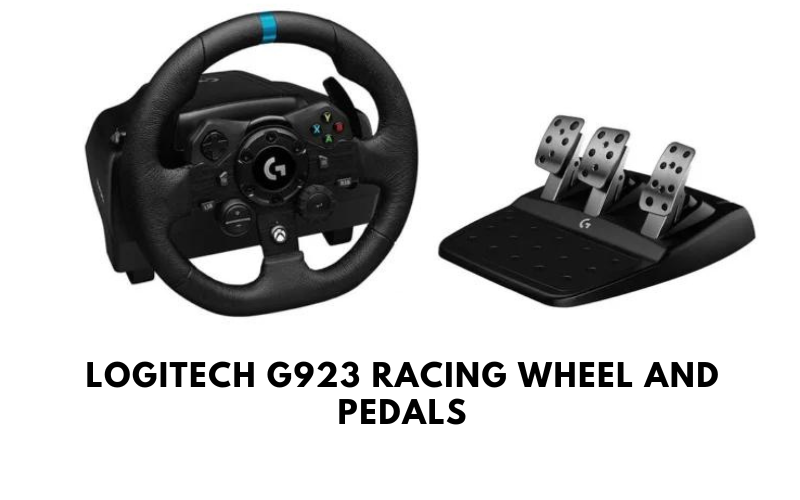
The Logitech G923 is the modern successor to the G29/G920, building on the same fundamental design while introducing the new TRUEFORCE feedback system. A comprehensive Logitech G923 review can provide more granular details.
Key Specifications
- Force Feedback: Gear-Driven with TRUEFORCE High-Definition Feedback
- Rotation: 900° Lock-to-Lock
- Compatibility: PlayStation 5, PS4, PC (A separate G923 model exists for Xbox)
- Pedals: 3-pedal set with a progressive spring in the brake for improved realism.
Objective Analysis
The G923 refines the classic Logitech formula. The primary innovation is TRUEFORCE, a high-definition force feedback system that integrates with a game’s audio engine to provide an additional layer of tactile vibration and detail. This allows the user to feel engine RPM, road texture, and other subtle cues through the wheel. It also features a 24-point selection dial for on-the-fly adjustments and a more responsive progressive brake pedal. It is an iterative evolution, aimed at users who want a plug-and-play experience with more sensory input than the previous generation. A common comparison is the Logitech G920 vs G29, which highlights the generational differences.
HORI Racing Wheel Apex
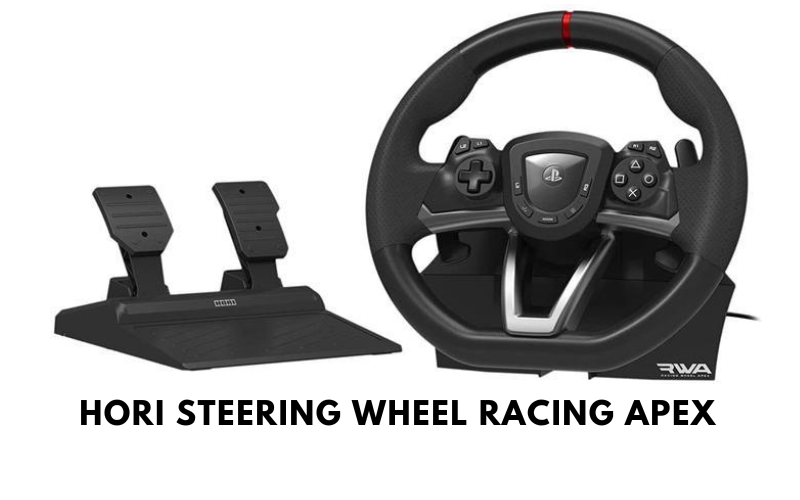
The HORI Racing Wheel Apex is positioned as a budget-friendly, officially licensed product for PlayStation and PC users. It prioritizes accessibility and ease of use over advanced simulation features.
Key Specifications
- Force Feedback: Vibration/Rumble Feedback (Not true FFB)
- Rotation: 270° Lock-to-Lock
- Compatibility: PlayStation 5, PS4, PC
- Pedals: 2-pedal set (Throttle, Brake)
Objective Analysis
It is critical to note that the HORI Apex does not have a true force feedback system. It uses rumble technology to provide vibration, adding a layer of immersion for crashes and road effects but without simulating steering torque. Its 270-degree rotation is more suitable for arcade-style sim racing games rather than hardcore simulations that benefit from 900 degrees. The build is primarily plastic, and it includes a basic two-pedal set. This wheel is a viable step up from a controller for casual players or for a family setup, but it lacks the core technology required for serious sim racing.
Thrustmaster T248
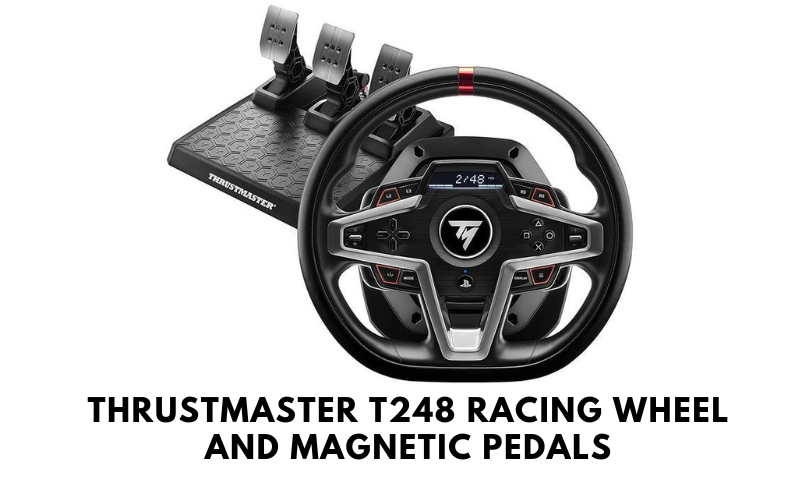
The Thrustmaster T248 is a direct competitor to Logitech’s G923 and represents the company’s mid-range offering, featuring advanced technology to deliver a smoother and more detailed experience. A deeper dive is available in the Thrustmaster T248 racing wheel review.
Key Specifications
- Force Feedback: Hybrid System (Belt + Gear)
- Rotation: 900° Lock-to-Lock
- Compatibility: PlayStation 5, PS4, PC (A separate model exists for Xbox)
- Pedals: T3PM 3-pedal set with magnetic sensors and four adjustable brake pressure modes.
Objective Analysis
The T248’s key advantage is its Hybrid Drive force feedback. The inclusion of a belt in the system results in a smoother, less “notchy” feel compared to pure gear-driven wheels, which many users find more realistic. Another standout feature is the interactive LCD screen on the wheel, which can display over 20 different data points, including speed, RPM, and gear position, in compatible games. The included T3PM magnetic pedal set is also a significant technical advantage, as magnetic sensors (H.E.A.R.T technology) do not wear out like traditional potentiometers, ensuring greater precision and longevity.
PXN V9
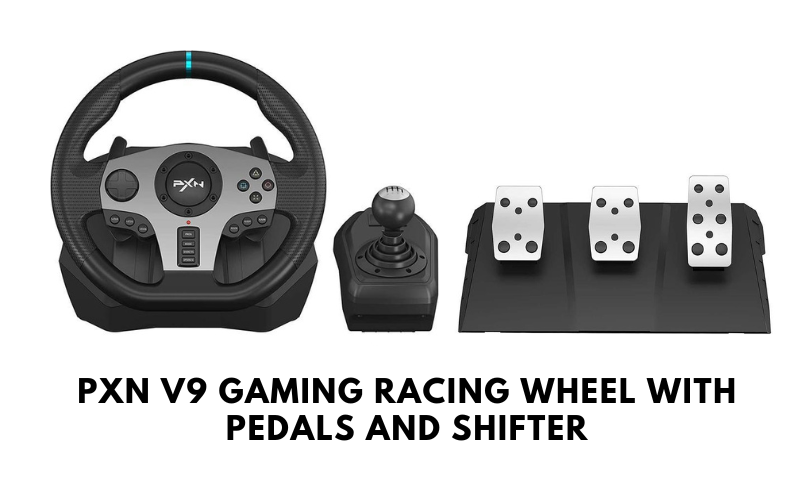
The PXN V9 is a budget-focused wheel that aims to provide a comprehensive feature set for a very low entry cost, including broad platform compatibility and an included shifter.
Key Specifications
- Force Feedback: Dual-Motor Vibration (Not true FFB)
- Rotation: Switchable 270° and 900° modes
- Compatibility: PC, PS4, Xbox One, Xbox Series X/S, Nintendo Switch
- Pedals: 3-pedal set (Throttle, Brake, Clutch)
Objective Analysis
Similar to the HORI Apex, the PXN V9 uses a vibration system, not a true force feedback motor. While it has two motors for rumble, it cannot simulate steering torque. Its most notable feature is value: the package includes a three-pedal board and a separate 6-speed H-pattern shifter, components that are sold separately for Logitech and Thrustmaster wheels. The ability to switch between 270-degree and 900-degree rotation offers versatility for both arcade and simulation titles. While the build quality is primarily plastic and lacks the premium feel of its competitors, the sheer number of features provided makes it an option for gamers on the tightest of budgets who want a complete manual driving setup.
Brand & Ecosystem Comparison: Which is Right for You?
Understanding each brand’s overall philosophy is as important as looking at individual product specs. This determines future upgrade paths and the types of experiences they cater to.
Logitech: The Entry-Point Powerhouse
Logitech specializes in the entry-to-mid-range market. Their products are known for being reliable, easy to set up, and widely compatible with most PS4 steering wheel games and PC titles. Their use of gear-driven technology is a proven, cost-effective design that provides a genuine force feedback experience, making them an ideal starting point for anyone serious about getting into sim racing.
Thrustmaster: The Mid-Range Specialist
Thrustmaster offers a broader range of products than Logitech, from entry-level wheels like the T128 to more advanced belt-driven bases like the popular Thrustmaster T300RS. Their focus on smoother hybrid and belt-driven systems provides a tangible step-up in feedback fidelity. The brand also has a more extensive ecosystem of add-on wheel rims and pedals, allowing for greater customization.
Fanatec: The Gateway to Professional Simulation
Fanatec operates in the mid-to-high-end space and is the brand most enthusiasts aspire to own. They are pioneers in making Direct Drive technology more accessible. Their ecosystem is entirely modular, allowing users to build a sim racing setup piece by piece, from wheelbases and steering wheels to pedals and shifters. While the initial investment is higher, the performance and quality are in a different league, catering to those who demand professional-grade equipment.
Hori & PXN: The Budget-Friendly Options
Hori and PXN serve the crucial budget segment of the market. Their focus is on providing an experience that is more immersive than a standard controller without the significant cost of true force feedback technology. They are excellent choices for casual racing game players, younger children, or anyone wanting to test the waters of using a wheel before committing to a more substantial investment. For those starting out, considering a stable platform like a best racing wheel stand can also improve the experience with these products.
Frequently Asked Questions (FAQ)
What is the main difference between Logitech and Thrustmaster wheels?
The primary technological difference is in the force feedback system. Logitech wheels (G29, G923) use a gear-driven system, which is strong but can feel slightly “notchy.” Thrustmaster’s competing models (like the T248) use a hybrid belt-and-gear system, which delivers a smoother, more fluid feedback that many users find more realistic.
Is Fanatec worth the higher cost?
For serious sim racing enthusiasts, Fanatec is generally considered a worthy investment. Their direct drive technology offers a substantially more detailed, powerful, and realistic force feedback experience that is a significant step up from gear or belt-driven wheels. The modular ecosystem also provides a clear, high-performance upgrade path.
Can you use a racing wheel with any racing game?
Most modern racing games on PC, PlayStation, and Xbox are designed with wheel support. However, the quality of the implementation can vary. Simulation titles like Assetto Corsa Competizione, iRacing, and Gran Turismo 7 have excellent force feedback integration, while more arcade-style racers might have simpler support. It’s always a good practice to check the game’s compatibility list.
What is the single biggest advantage of a direct drive wheel?
Fidelity. Because the wheel is connected directly to the motor, there is no loss of detail through gears or belts. This means the user feels every subtle nuance of the tire behavior, road texture, and weight transfer with unmatched clarity and responsiveness, which can translate to better car control and faster lap times.
Do I need a dedicated stand or cockpit for a racing wheel?
While all the wheels listed can be clamped to a sturdy desk, a dedicated best sim racing cockpit or wheel stand is highly recommended. It provides a much more stable and rigid platform, preventing any flex or movement during intense driving, and ensures your pedals do not slip. This is especially important for more powerful wheels.
How much does a complete sim racing setup cost?
The cost can vary dramatically. An entry-level setup with a Logitech or PXN wheel mounted to a desk can cost a few hundred dollars. A mid-range setup with a Thrustmaster wheel and a dedicated stand might be in the $500-$800 range. High-end setups with Fanatec direct drive, load cell pedals, and a full cockpit can easily exceed several thousand dollars. The full breakdown depends on the components chosen, and it’s worth exploring how much a sim racing setup costs in detail.

With a background in mechanical engineering and over a decade in competitive sim racing, Kenji serves as our lead Sim Racing Physics & Hardware Analyst. He deconstructs complex topics like force feedback and suspension geometry, helping readers understand the crucial engineering behind a perfect lap time. Kenji’s passion is to translate real-world motorsport principles into actionable knowledge for the sim racing community.
